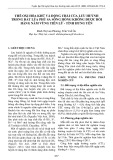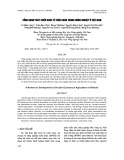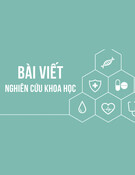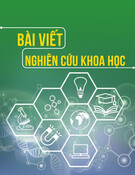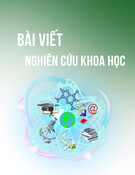
Nong Lam University, Ho Chi Minh City 1
The Journal of Agriculture and Development 23(Special issue 1) www.jad.hcmuaf.edu.vn
Sustainable livelihood development and cultural preservation through agricultural tourism:
local community perspectives from Dak Lak province, Vietnam
Hong T. A. Phan*
Tourism and Hospitality Management Faculty, Vietnam Women’s Academy Ho Chi Minh City, Vietnam
ARTICLE INFO ABSTRACT
Research Paper
Received: September 04, 2024
Revised: October 15, 2024
Accepted: October 17, 2024
Keywords
Agricultural tourism
Cultural preservation
Dak Lak
Local community
Sustainable Livelihood
*Corresponding author
Phan Thi Anh Hong
Email:
PTAnhHong@hvpnvn.edu.vn
This study conducted in collaboration with the local community
focused on sustainable agricultural tourism development in Dak
Lak, Vietnam. Using a qualitative research method, we conducted
in-depth interviews with 29 households and agricultural
cooperatives, combined with case studies. The results showed
that agricultural tourism, a product of our joint efforts, played a
significant role in diversifying livelihood sources and contributing
to the preservation of ethnic and cultural identity. However, the
sustainable development of this sector was hindered by limitations
in infrastructure, lack of investment and uneven management
capacity. Based on these findings, we propose specific policies and
solutions to promote sustainable agricultural tourism development
and support rural communities in the context of economic
transition.
Cited as: Phan, H. T. A. (2024). Sustainable livelihood development and cultural preservation
through agricultural tourism: local community perspectives from Dak Lak province, Vietnam. The
Journal of Agriculture and Development 23 (Special issue 1), 1-18.
1. Introduction
Agricultural tourism, a harmonious
combination of agriculture and tourism, has
become an effective model for sustainable rural
development globally (Barbieri et al., 2019;
Phillips et al., 2021). This model helps diversify
income sources for farming households and
contributes to the preservation of local culture the
protection of the natural environment (Ghaderi
et al., 2022; Ruiz-Labrador et al., 2023). In the
context of developing countries, agricultural
tourism offers attractive opportunities for socio-
economic transformation, particularly in regions
with rich agricultural heritage and biodiversity
(Despotović et al., 2017).
With its diverse terrain and long-standing
agricultural tradition, Vietnam offers great
potential for agricultural tourism development
(Pham, 2023). Remarkably, the Central
Highlands region, known for being the largest

2 Nong Lam University, Ho Chi Minh City
The Journal of Agriculture and Development 23(Special issue 1) www.jad.hcmuaf.edu.vn
coffee-producing area in the country and its
cultural diversity among ethnic minorities, is
gaining attention as a potential destination for
agricultural tourism (Bui & Nguyen, 2014). Dak
Lak province, located in the heart of the Central
Highlands, with its extensive coffee cultivation
and ethnic diversity, faces both opportunities
and challenges in developing this tourism model.
Although there has been considerable research
on agricultural tourism globally (Kline et al.,
2016; Ospanova et al., 2022), studies within the
context of Vietnam, particularly in the Central
Highlands with its unique cultural diversity
among ethnic minorities, remain limited. Existing
research mainly focuses on the economic aspects
of agricultural tourism (Nguyen, 2022), while
the reciprocal relationship between agricultural
tourism and the preservation and enhancement
of ethnic minority cultural identity has not
been fully explored. Specifically, the role of local
communities in integrating traditional cultural
values into agricultural tourism activities, as well
as the impact of tourism on cultural change and
adaptation among ethnic minority communities,
are areas that require further investigation.
Findings from previous studies highlight
the need for a more comprehensive and
multidimensional approach to researching
agricultural tourism development in Dak Lak.
This approach should consider the multifaceted
nature of sustainability within the specific local
context, particularly the relationship between
agricultural tourism, community livelihoods and
the preservation of ethnic minority cultures. This
study aims of this study is to provide insights into
the current situation, challenges and solutions
for sustainable agricultural tourism development
in Dak Lak, from the perspective of the local
community.
This study focuses on three main aspects:
(1) How is agricultural tourism in Dak Lak
impacting the livelihoods and culture of the local
community? (2) What challenges and barriers
do the local community face in developing
agricultural tourism in Dak Lak? (3) What
policies and solutions need to be implemented
to support sustainable agricultural tourism
development in Dak Lak?
This study is significant both for Dak Lak
province and for contributing to the literature
on sustainable tourism in developing countries
(Sharpley, 2020) and addresses the need for more
specific research on the impacts of agricultural
tourism (Gomez-Arroyo et al., 2013). The
research findings will provide additional
information for policymakers and practitioners
in similar global contexts and contribute to the
theory of sustainable rural development within
transitional economies.
2. Literature Review
2.1. Agricultural tourism and sustainable
development
In the broader picture of sustainable rural
development, agricultural tourism emerges as
an indispensable piece. In recent years, there has
been a surge in research on this field, ranging
from a global perspective to analyses within the
context of Vietnam.
Kline et al. (2016) initiated research on the
multifaceted impacts of agricultural tourism,
highlighting its role in generating income and
preserving agricultural heritage. Barbieri et
al. (2019) found that communities engaged
in agricultural tourism are more resilient to
economic and environmental shocks. Ospanova
et al. (2022) linked agricultural tourism to
food security, viewing it as a bridge between
production and sustainable consumption.
Phillip et al. (2021) introduced a new framework
for assessing the sustainability of agricultural

Nong Lam University, Ho Chi Minh City 3
The Journal of Agriculture and Development 23(Special issue 1) www.jad.hcmuaf.edu.vn
is considered a key factor in sustainable tourism
development in that area (Bui, 2021). The
community’s indigenous knowledge is crucial
for creating unique and attractive tourism
products (Nguyen & Truong, 2019). Le (2020)
emphasized that local community involvement
in agri-tourism planning in Dak Lak is essential
to balance economic growth and environmental
protection, enhancing their understanding of
sustainable resource use.
2.3. Sustainable livelihoods and cultural
preservation in agricultural tourism
In the broader context of rural development,
agricultural tourism emerges as a versatile tool
that b enhances livelihoods and preserves the
cultural identity of local communities. Gao &
Wu (2017) assert that agricultural tourism is not
merely an economic activity but also a catalyst for
comprehensive rural development and poverty
reduction. Similarly, Ghaderi et al. (2022)
found that agri-tourism in Iran has provided
an economic safety net for farmers, enhancing
their livelihoods by stabilizing incomes and
strengthening community resilience to economic
shocks. Garrido-Pérez et al. (2022) noted its
role in preserving agricultural heritage, while
Ruiz-Labrador et al. (2023) emphasized its value
in maintaining biodiversity and transmitting
indigenous knowledge.
In Vietnam, the wave of research on
agricultural tourism is equally dynamic. Thieu
(2021) emphasizing that agricultural tourism
has become a “two-in-on” tool, improving
income while also serving as an effective means
for preserving and promoting local culture.
Vu (2023) argued that agricultural tourism
has created a new “stage” for traditional crafts,
helping them survive and thrive in the modern
context. Dao (2021) suggested that agricultural
tourism has transformed cuisine from an
“intangible” cultural aspect into a “tangible”
tourism under climate change, emphasizing
adaptability as a key factor for future success.
In the context of Vietnam, the wave of research
on agricultural tourism is equally dynamic.
Agricultural tourism has become an effective
tool for preserving and promoting the traditional
cultural values of ethnic minority communities
(Do et al., 2022; Duong et al., 2023). Nguyen et
al. (2022) emphasized that despite being heavily
impacted by Covid-19, agri-tourism in Dak Lak
province still plays an important role in the local
economy, accounting for a significant proportion
of production value. Duong et al. (2023)
analyzed the potential for developing various
types of ecotourism in Dak Lak, including the
integration of agri-tourism and ecotourism, by
building branded tourism products that create
unique experiences, combining environmental
protection with sustainable development.
2.2. The role of local communities in sustainable
agricultural tourism development
Local communities play a crucial role in
sustainable agricultural tourism. Wannaprasert &
Choenkwan (2021) argue that active community
participation improves tourism experiences
and enhances resilience against economic and
environmental challenges. Karim et al. (2021)
highlight the importance of social capital, noting
that strong social networks and community trust
are vital for sustainable development. Ciolac
et al. (2022) add that digital technology can
support this by connecting farmers with tourists
and optimizing resource management through
online platforms.
In Vietnam, many studies found that
community participation in planning and
management enhances project effectiveness
and ensures equitable distribution of benefits
(Le, 2020; Bui, 2021). The involvement of
local communities in decision-making,
implementation and sharing of tourism benefits

4 Nong Lam University, Ho Chi Minh City
The Journal of Agriculture and Development 23(Special issue 1) www.jad.hcmuaf.edu.vn
3. Research Methodology
This study employs a qualitative approach and
a case study methodology, to explore sustainable
agricultural tourism development in Dak Lak
province, Vietnam. This method is chosen for its
ability to provide a comprehensive view of the
experiences, perspectives and challenges faced
by local communities in developing agricultural
tourism (Creswell & Poth, 2016).
3.1. Research objectives and sampling method
This study employs a purposive sampling
method combined with snowball sampling to
ensure the inclusion of diverse and relevant
participants aligned with the research
objectives (Patton, 2015). The data collection
was conducted from January to June 2024.
Table 1 presents a summary of the specialized
agricultural cultivation areas and the distribution
of samples across five distinct subregions in Dak
Lak province. The selection of participants was
conducted carefully, based on the characteristics
of each subregion, and focused on individuals
actively involved in agricultural production.
tourism product, contributing to both the
preservation and widespread promotion of local
culinary values. Nguyen (2022) emphasized that
agri-tourism contributes both to the preservation
of indigenous culture and to the diversification
of livelihoods for local residents. The integration
of agricultural activities with tourism creates
economic opportunities while facilitating the
preservation and promotion of the community’s
traditional cultural values.
Overall, despite numerous studies on
sustainable agricultural tourism, some important
aspects remain underexplored, especially in
the context of Dak Lak province. Additionally,
long-term research on the impact of agricultural
tourism on the livelihoods and culture of ethnic
minority communities in Dak Lak is limited,
with a lack of in-depth studies on the local
communities involved in agricultural tourism and
the challenges and barriers they face. Focusing
on the voices of these communities helps address
these research gaps and ensures that policies and
practices in agricultural tourism development
accurately reflect the needs and perspectives of
local residents, contributing to the creating of a
truly sustainable and equitable agrarian tourism
model in Dak Lak.
Table 1. Summary of the area of specialized agricultural cultivation and the number of samples
No. Code Sub-region Area (%) Specialized crops Sample
1SR1 Krong Ana - Serepok
River Delta
14.51 Food production such as rice and
corn, cocoa...
10
2SR2 Chu Yang Sin high-
lands
3.98 Forestry and agroforestry 2
3SR3 Ea Sup Plain Subre-
gion
28.43 Cashew, wet rice, fruit trees and me-
dicinal plants, industrial crops
4
4SR4 Buon Ma Thuot –
Ea H’leo Plateau
16.17 Long-term industrial crops for com-
mercial production, such as coffee,
rubber, pepper and durian...
11
5SR5 M’Drak Highland and
Mountainous
15.82 Industrial crops such as cocoa, fruit
trees and plantation forests
2

Nong Lam University, Ho Chi Minh City 5
The Journal of Agriculture and Development 23(Special issue 1) www.jad.hcmuaf.edu.vn
The study ultimately included 29 participants
with diverse occupations in the field of agricultural
tourism, including individuals and households
involved in agricultural tourism, representatives
from cooperatives and local tourism managers
currently engaged in agricultural tourism
activities. Table 2 provides a summary of the
occupations of the participants.
No. Code Tourism - related Job Sub-region Location Gender Age
1 LP001
Coffee plantation and processing facility
SR4 Buon Ma Thuot Male 45
2 LP002 Coffee plantation owner SR4 Buon Ma Thuot Male 33
3 LP003 Coffee plantation owner SR4 Buon Ma Thuot Male 51
4 LP004 Coffee plantation owner SR4 Cu M’gar Male 38
5 LP005 Coffee plantation owner SR4 Cu M’gar Male 60
6 LP006 Coffee plantation owner SR5 M’Drak Male 36
7 LP007 Cocoa farm owner SR4 Buon Ma Thuot Male 45
8 LP008 Cocoa farm owner SR1 Krong Ana Female 37
9 LP009 Pepper plantation owner SR4 Buon Ma Thuot Male 43
10 LP010 Pepper plantation owner SR1 Krong Ana Male 35
11 LP011 Pepper plantation owner SR1 Buon Don Female 65
12 LP012 The fruit orchard owner SR5 M’Drak Female 46
13 LP013 The fruit orchard owner SR1 Buon Don Female 58
14 LP014 The fruit orchard owner SR3 Ea Sup Male 55
15 LP015 The fruit orchard owner SR1 Krong Ana Male 37
16 LP016 Vegetable garden owner SR3 Ea Sup Female 45
17 LP017 Vegetable garden owner SR4 Cu M’gar Female 58
18 LP018 Herb garden owner SR4 Buon Ma Thuot Female 42
19 LP019 Herb garden owner SR1 Buon Don Female 65
20 LP020 Goat farm owner SR1 Buon Don Male 45
21 LP021 Fish farm owner SR3 Ea Sup Male 33
22 LP022 Fish farm owner SR2 Lak Male 60
23 LP023 Agricultural cooperative SR1 Buon Don Male 46
24 LP024 Agricultural cooperative SR4 Cu M’gar Male 41
25 LP025 Local tourism management SR3 Ea Sup Male 50
26 LP026 Local tourism management SR1 Krong Ana Male 55
27 LP027 Homestay owner SR2 Lak Female 47
28 LP028 Homestay owner SR1 Krong Ana Female 49
29 LP029 Farm product store SR4 Buon Ma Thuot Female 60
Table 2. Summary of surveyed participants




![Bài giảng Tiếng Anh chuyên ngành Bảo vệ thực vật [chuẩn nhất]](https://cdn.tailieu.vn/images/document/thumbnail/2025/20250506/vinarutobi/135x160/5631746530031.jpg)

